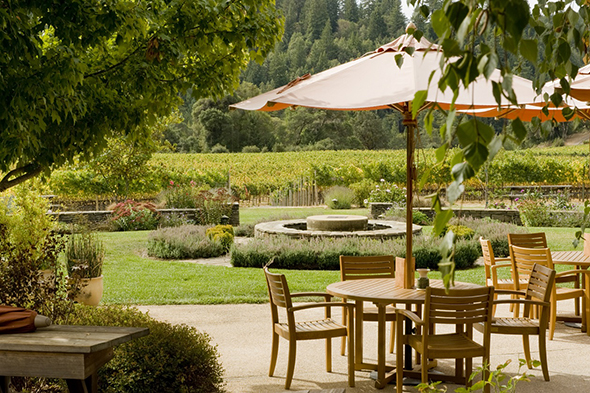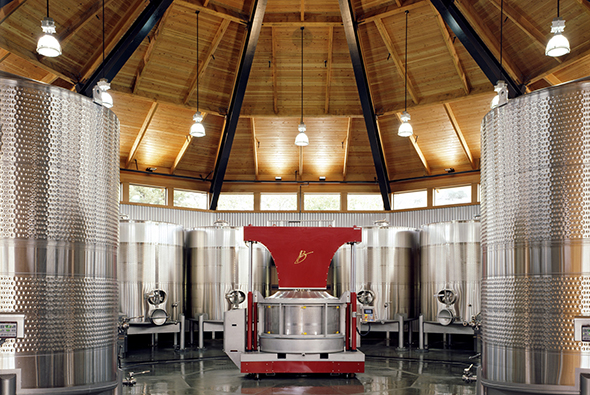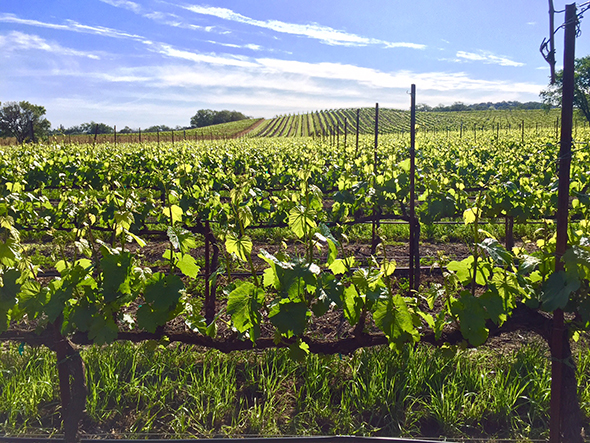Creating Memorable Moments with Duckhorn Wine Company

It was a true love fest. Hundreds of wine fans wandering blissfully from table to table sniffing and sipping flavorful offerings of new Pinot Noir releases made with pristine fruit grown in the coastal region of Anderson Valley in Mendocino County. Set inside a spacious white tent surrounded by beautiful vineyards near Philo in mid-May, this momentous event marked the 20-year anniversary of the Anderson Valley Pinot Noir Festival and two decades since the first Pinot Noir grapes planted by Goldeneye Vineyards, the hosts of the event, were picked on the estate property.
Although he worked down the road as winemaker at Husch Winery when Duckhorn Wine Company began developing the Goldeneye property in the 1990s, Duckhorn Chief Operating Officer, Zach Rasmussen, remembers that exciting period very well.
“To me, it became very obvious that Dan (Duckhorn) was passionate about what he believed in. In the case of Anderson Valley, his ultimate goal was to develop a winery that was focused on showcasing the special characteristics of Pinot Noir, the sites where the grapes are grown, and the appellation as a whole.”
Today, this artisanal approach has resulted in 136 acres of planted vineyards; three annual releases that have gained a widespread following by Pinot Noir lovers around the globe; and the integration of the Goldeneye label into the company’s robust wine portfolio, which includes high-profile winery Duckhorn Vineyards, Paraduxx, Migration, Decoy, and Canvasback.
It’s a journey that began when Dan and his former wife, Margaret Duckhorn, founded the original Duckhorn Vineyards wineries near the sleepy town of St. Helena in 1976. At the time, there were only 40 wineries in Napa Valley. After producing their first 1,600 cases (800 of Cabernet and 800 of Merlot) in 1978, Dan followed his passion for the magnificent red wines from the famous Bordeaux regions of Pomerol and St. Emilion to help establish Merlot as one of North America’s great premium wine grapes in the early 1980s. In 1982, the winery released the first offering of its crisp, clean, and elegant style of Sauvignon Blanc, which has since become its signature white wine.
Like successful architects, artists, designers, star chefs and other types of entrepreneurs, great wineries do more than just endure—they evolve, innovate, learn and lead. This has been Duckhorn Wine Company’s signature since the beginning, and as a result the winery in their portfolio continue to stay relevant, consistent, and pleasing to the palates of a wide range of consumers.
Thus, once the Duckhorn winery was humming, new opportunities and fresh ideas culminated in the development of the Paraduxx winery, one of the early proprietary blends of Napa Valley, in 1994; two years later, the establishment of the Goldeneye played an essential role in positioning Anderson Valley Pinot Noir on wine lists, retail shelves, and in cellars around the globe; and in 2001 the company launched Migration, a marvelous winery focused on making elegant and sophisticated styles of Chardonnay and Pinot Noir with premium fruit from Sonoma County and the Central Coast. Together, these new wineries helped the company become more recognized for benchmark wines and offering more diversity in terms of grape varietals, price points, categories, and regions. Therefore, while other wineries have been consolidating production and carving up assets, the Duckhorn Wine Company has continued to move forward.
Granted, it’s been over four decades since Duckhorn was founded. Therefore, to continue the pursuit of producing world-class wines with duck names and vivid images integrated into the labels, the innovative team of 300 employees is led by President and Chief Executive Officer, Alex Ryan, who began working at Duckhorn Wine Company in high school before moving up the ranks, developing his skills in the vineyards and production.

In a recent interview, Ryan says a critical key to success for the company is based around cross-promoting all six of the wineries under a single waterfowl theme. “This is very much a trust-based relationship. Once we earn their trust with one winery, consumers are motivated to migrate to our other wineries. We support this migration by making it easy for customers to find other wines in our portfolio. A duck on the label is our guarantee that the wine in the bottle is the finest that could be made from that vintage and appellation. This is an incredibly powerful tool in such a crowded marketplace.”
Granted, crafting wines that deliver beyond expectation is not an easy task. To build the foundation for these exciting new wineries and increasing the quality of fruit the wine is made with, the company began acquiring an impressive series of vineyards and new sites in 1976. With long-term investments of tens of millions of dollars spread throughout Napa Valley, Sonoma County, Anderson Valley and Washington State, the estate program now includes almost 700 acres of vineyards. To balance risk and reward, each site was researched in detail in order to insure the destiny of the grapes from the ground up. In 2015, the company was able to purchase the historic Three Palms Vineyard near St. Helena, which has been a crown jewel of the Duckhorn Merlot program for nearly 40 years.
To build infrastructure for the future, the company has also spent more than 60 million dollars in facility upgrades; high-tech equipment; and the integration of sustainable farming techniques, Fish Friendly Farming practices, and LEED certification on a number of buildings, as well.
One of the newer wineries to tie the back of the house together is Decoy, a bright, young winery that now features a new winemaking facility, barrel room and estate vineyard located in the bustling agricultural zone of Hopland in Mendocino County. To insure the Cabernet Sauvignon and other Bordeaux varieties they work with over-deliver for the price, the company acquired the beautiful Ridgeline Vineyard, which overlooks the Alexander Valley just over the Sonoma County border. The positive results are already showing. As a result, Decoy is considered the standard for affordable, luxury American wine and is a powerful gateway for wine lovers trading up to fine wine.

But make no mistake – it’s a team effort. That is especially true for marketing and selling the wine, which is done in-house through the integration of dedicated winemakers and estate vineyards, the public relations and social media departments, wine club and tasting room staff members, and controlling the destiny of the wines in the marketplace with its own Duckhorn Wine Company distributorship. Under the leadership of Alex Ryan, this team has forged groundbreaking cross-industry partnerships, expanded into numerous new markets (over 50 countries), and established a wine club program that is almost 10,000 members strong.
Before becoming the Vice President of Winemaking for Duckhorn Wine Company, Neil Bernardi was the enologist at Goldeneye in 2005 and winemaker for Migration in 2009, so he has seen the growth of the company from many different angles over the past decade.
“I’m very proud to be associated with such a historic winery, new winery on the rise and a legacy that continues to attract followers who like drinking a wide-range of world-class wines,” says Bernardi. “But when it comes down to it, what we are doing today is based around that same ‘brick and mortar’ concept that the winery was founded around in the 1970s. For that reason, the real core of our job is to work with the best possible grapes and making sure the land and vines are preserved for the people in our positions for many generations to come.”
To continue the move forward, the company founded Canvasback in 2012, an exciting new winery established in 2012 on Red Mountain in Washington State. Located near the charming city of Richland and the Columbia River Gorge, this special winegrowing region is known for its mineral rich soils and dry, desert-like conditions. With a perfect balance of warm days and cool nights, the small berries on the clusters develop slowly which, in turn, help produce annual offerings of world-class Cabernet Sauvignon, highlighted by concentrated flavors; robust tannins; structure; and a long, engaging finish.
In addition to working with the estate fruit from the 20-acre Longwinds Estate Vineyard, winemaker, Brian Rudin, and winegrower, Dick Bousey, work in tandem with premiere grapes sources from some of the high-profile vineyards in the region, including the Klipsun, Quintessence, Shaw and Ciel du Cheval. When the debut vintage received great acclaim and sold out almost immediately, the road to success was swift and the team has never looked back. Earlier this year, the winery released the inaugural bottling of the Canvasback 2014 Grand Passage Red Mountain Cabernet Sauvignon, which is a true gem to cellar for 10-20 years.
“It’s a great community effort,” says Bernardi. “Not only are the natives of the region welcoming and supportive, but they also offer advice and are willing to collaborate so that all parties involved can benefit in the end.”
Text by Christopher Sawyer

